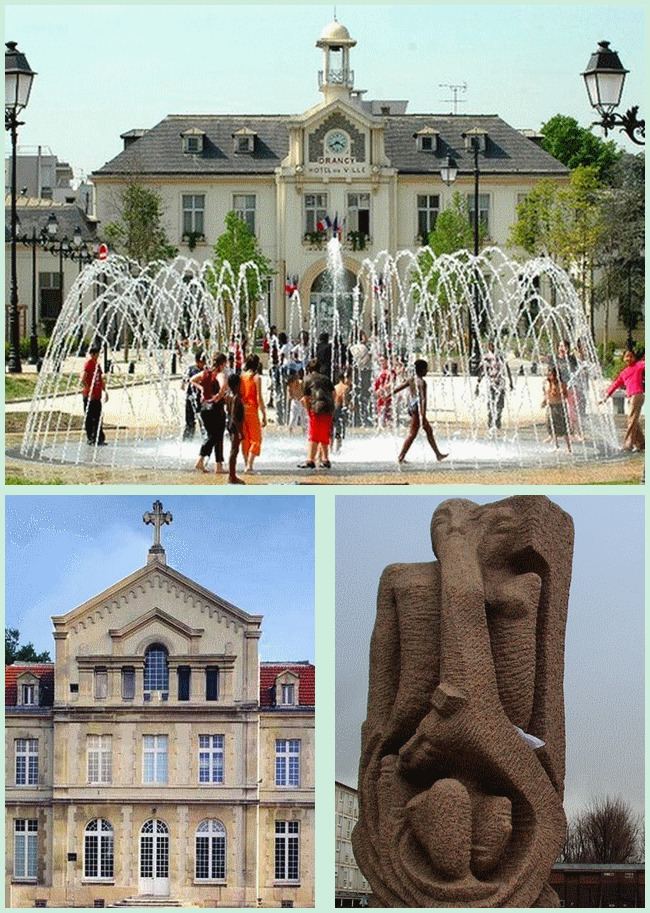Area 7.76 km² Arrondissement Bobigny | Region Île-de-France Canton Drancy Population (2010) 68,241 Local time Monday 8:51 PM Team JA Drancy | |
 | ||
Weather 7°C, Wind W at 16 km/h, 80% Humidity Mayor Jean-Christophe Lagarde (New Centre) | ||
Drancy ([dʁɑ̃.si]) is a commune in the northeastern suburbs of Paris in the Seine-Saint-Denis department in northern France. It is located 10.8 km (6.7 mi) from the center of Paris.
Contents
- Map of Drancy France
- Toponomy
- Origins to 20th century
- 20th and 21st centuries
- Climate
- Architecture
- Park and Castle of Ladoucette
- Administration
- Railways and buses
- Roads
- Education
- International relations
- References
Map of Drancy, France
Toponomy
The name Drancy comes from Medieval Latin Derenciacum, and before that Terentiacum, meaning "estate of Terentius", a Gallo-Roman landowner.
Origins to 20th century
In the 17th century, Drancy was divided into two distinct villages: Drancy le Grand and le Petit Drancy. The quarter "Village Parisien" is built on the old location of the hamlet of Groslay which was surrounded by the forest of Bondy — hence the name of rue des Bois de Groslay.
The end of nineteenth century was marked by the industrialisation and by the development of rail transports. During the Franco-Prussian war, Le Bourget was the site of an important battle and the castle of Ladoucette in Drancy was destroyed.
20th and 21st centuries
During the second world war, Drancy was the site of the Drancy internment camp where Jews, Gypsies, and others were held before being shipped to the Nazi concentration camps. In 1976, the Memorial to the Deportation at Drancy was created by sculptor Shlomo Selinger to commemorate the French Jews imprisoned in the camp.
Climate
Architecture
Drancy's buildings are too diverse to be characterised by any particular architectural style. We can see traditional houses from different periods. Some of them with a style Art Nouveau are typical of the 19th and 20th centuries. We can see housing estates and a garden city. Most recently, full of small buildings were built.
Park and Castle of Ladoucette
The parc de Ladoucette is the only park of Drancy. It contains a pond, a small educational farm and the castle of Ladoucette. The castle was built in 1533 by Pierre Séguier. In the 19th century, the castle was the property of the senator Charles-Loetitia de Ladoucette, in 1874 his wife, la baronne de Ladoucette dies and her body was placed in the Mausoleum de la baronne de Ladoucette, today she is buling in the parisian cimetery.
Administration
Part of the commune form the canton of Drancy. The other part belongs to the canton of Le Bourget.
Railways and buses
Drancy is in Zone 3 of the Carte orange. The city is served by Le Bourget station and by Drancy station on Paris RER line B. Le Bourget station is situated near Drancy. The RER B is one of the five lines in the RER Rapid transit system serving Paris and its suburbs.
Drancy is also served by the Paris Tramway Line 1 with five stops and by twelve buses.
By the RER B, Drancy is near many parisian railway stations, Gare du Nord is now just 10 minutes away, gare Saint-Lazare and gare de Lyon can be reached in 30 minutes. Charles de Gaulle Airport can be reached in 30 minutes too.
Roads
Drancy is served by the A3 motorway and the A86 motorway.
Education
Schools:
International relations
Drancy is twinned with:
Willenhall Eisenhüttenstadt Gorée